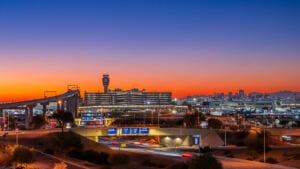Maricopa County is one of several Arizona counties that received a failing grade in air cleanliness based on high ozone days and high particle pollution days, according to the latest State of the Air report by the American Lung Association. And among cities, Phoenix is one of the 15 worst for pollution.
The report, released Thursday, found that the western U.S. experienced particularly bad air quality compared with the rest of the country from 2018 to 2020.
When the first State of the Air report came out in 2000, it found eastern states had the worst air because of major cities in New York, New Jersey, Pennsylvania and elsewhere. But recent reports have given these states passing grades, finding instead that the West has the least healthful air in the U.S.
READ ALSO: As the drought persists, here’s how Phoenix is prepared
JoAnna Strother, senior director of advocacy for the American Lung Association, said climate change is one of the biggest factors in the increasingly unhealthy conditions in the West, as wildfires raged across the western U.S. in record numbers over the last few years. Additionally, rising temperatures further contribute to bad air quality.
The report points to policy-driven reductions in emissions in some states and climate change-fueled increases in pollution in others as a major cause for the disparity between the eastern and western U.S.
“We want people to be aware of the quality of the air they’re breathing in,” Strother said, “because it can impact their lung health, and we know that as climate change continues, it’s harder to clean up air pollution.”
High daily particle pollution is responsible for nearly 48,000 premature deaths every year in the U.S., according to the report.
Daily spikes in particle pollution have been found to cause increased mortality in infants, severe asthma attacks, and hospital admissions for cardiovascular disease and chronic obstructive pulmonary disease. Ozone air pollution, also known as smog, is a dangerous lung irritant that increases risk of severe respiratory illness for those exposed to high levels, the report said.
In the 2022 report, Phoenix ranked 11th highest in the country for daily “short-term” particle pollution and eighth for annual particle pollution. Additionally, Phoenix ranked fifth most polluted by ozone.
Strother said 84% of people in Arizona live in communities that received “F” grades for their air quality, with Maricopa and Pinal counties among the most polluted.
Some of the groups most at risk for unhealthy air include adults older than 65, people with underlying lung-health conditions, people living in poverty and people of color, State of the Air said. Strother and the lung association are hoping for policy changes at the local and federal levels that would help decrease this disparity.
“We know that our communities of color are usually located near polluting sources, so, next to power plants, next to freeways, where they’re breathing in more unhealthy air,” Strother said. “We need to do a better job at cleaning up the air quality, so that our communities of color can be protected, so that people with sensitive lung health issues can be protected.
“But of course, everyone in Arizona should be breathing in cleaner air.”
Strother said policy change is crucial to ensure that growing children are given the opportunity to breathe clean air.
“We’re definitely concerned about our future generations,” she said. “We want them to have the best future possible, to be healthy. And so that’s why it’s so important that we start to act now to start to clean up our air pollution, especially as climate change makes it harder to do. So we need to do a harder job as well to clean up the air here in Arizona, and really, across the country.”
Much of the progress that has been made to date stems from laws and regulations, such as the Clean Air Act, passed in 1970, Strother said. However, much more remains to be done, and she hopes the Biden administration will act to move the entire U.S. further onto a path toward cleaner air.
Transportation remains one of the biggest polluters, especially as more people move to Arizona and put more vehicles on the road each day.
Timothy Franquist, environmental director at the Maricopa Association of Governments, said one way Maricopa County has tried to reduce ozone pollution is by employers implementing trip reduction programs that cut car travel.
Additionally, the COVID-19 pandemic drastically changed the way that many people work by forcing employers to find ways to allow employees to work from home. Franquist said adapting to work-from-home styles had positive effects on reducing ozone emissions.
“I think being post-COVID, you know, the telework environment is very different,” he said. “Now, I think that it’s established, it’s here. And so that’s always a good thing to do to really reduce your driving, or carpooling and taking mass transit when you can.”
Some changes Strother would like to see in Arizona would be investing in infrastructure to support zero-emission vehicles and moving to renewable and noncombustible energy sources.
“Poor air quality can be harmful as you breathe it in, and harmful on the body,” she said. “Even healthy people can experience symptoms, shortness of breath, coughs, those itchy watery eyes. So we want people to be aware that it can have an impact on your lung health.”




